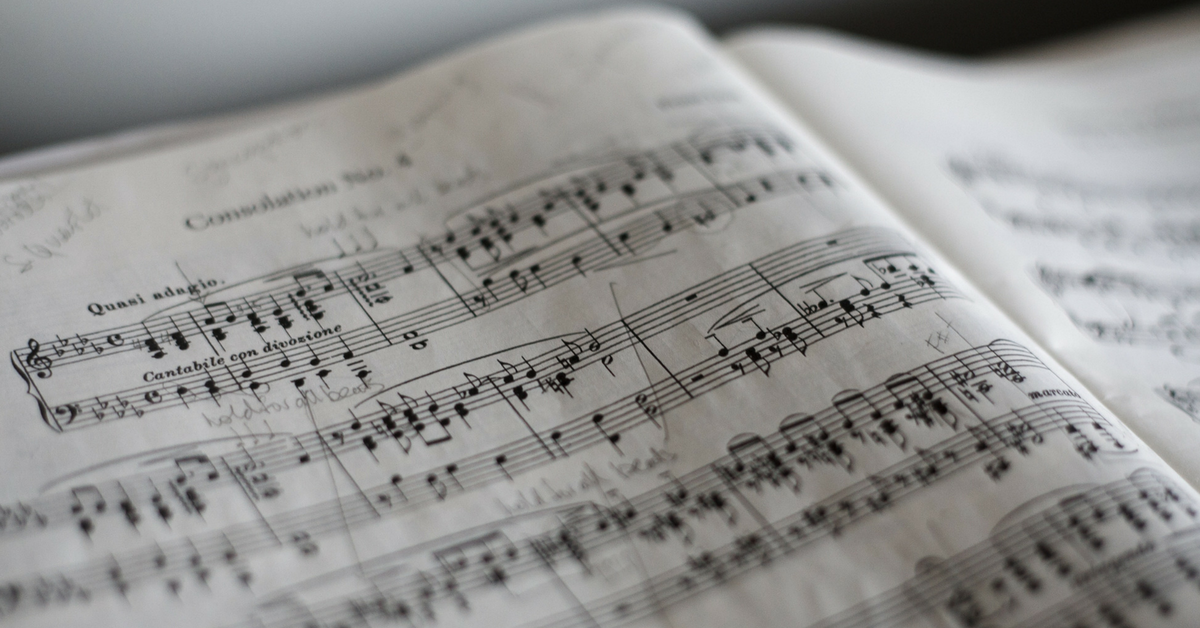One story we hear from our users goes something like this: “I’ve always wanted to compose, but I just didn’t have the right tools… with Noteflight I can jump right in and start writing music!”
We love hearing this, of course, but is it always that simple? Once you know how to enter notes and rhythms into a Noteflight score, how do you keep going? How can you shape and structure your composition so that it sounds satisfying to you — and to your fans?
This article offers some possible answers to these questions. If you want to try your hand at composing, you can use this article to help structure your work. Similarly, teachers can use this article as a source of ideas for composition assignments.
This article is not only for beginners: it’s also for those of you who already compose but feel like you’re getting stuck somehow. It’s nice to have some basic tools and operating procedures on hand to get you past the point of first inspiration to create a complete piece.
Getting started
How do composers come up with their starting idea for a piece? This process is often mysterious, even to composers themselves. For some of you, it might “just happen.” While riding the bus or washing the dishes, a tune — or just a few notes, or a rhythm — might pop into your head.
Or, you might improvise on an instrument, or whistle or hum for a while, and in the process, a musical idea might come together in your mind.
If you can hum or play your idea, you might want to record it as a memory aid for later (many cell phones have a voice memo feature). Then when you have time, grab a pencil and staff paper and jot it down.
When you’re ready, press the magical “New Score” button and put your idea into Noteflight:
Another option might be to compose directly in Noteflight. Start with that magical button, then add some notes, and tweak them until it sounds good. You don’t even have to know yet what instrument will play it: just pick one and you can always change it later.
Suggestion: Before you start, set some limits. A limit might be practical: what range of notes can you sing? what range of notes can your instrument(s) play? (for example, an oboe can’t play lower than the B-flat below middle C). Or the limit might be something arbitrary that you choose: five specific pitches, or using only dotted 8th notes, or certain harmonies, or playing techniques such as staccato, and so on. You can place limits on yourself, or if you’re a teacher you can set some for your students.
What is it?
However you got there, you now have a musical idea. Your idea might be a few notes or rhythms, or it might be a whole phrase…. perhaps something like this:
Next, take a look at your idea: what do you have? Don’t worry about whether it’s “good” yet. Who knows! You can always start over later. For now, just forge ahead.
Notice a few basic things about your idea. For example, our sample melody is in a minor key. And it only uses five of the seven notes in that key. The E-flat only appears twice, and the A only once, so most of the idea is just three notes: B, C, and D. The default tempo in Noteflight is quarter = 120 beats per minute, but this one felt right a bit slower. Experiment with tempo to make it sound just how you want. What about the rhythms? There is a repeated rhythm, dotted-8th plus sixteenth, that seems to crop up a lot. More on that later: for now, just look at the idea you composed, and notice what you can notice.
What’s the big idea?
The good news is, now you have a musical idea! But how can you turn that into a complete piece? A next step is to clearly define the true identity, or character, of your idea. Your idea is like a person with a unique face and voice. What makes that face and voice individual and recognizable?
- is it the rhythm? (a melody might be distinctive because of its rhythm more than its notes)
- the melody?
- the harmony?
- where, exactly, does the ‘idea’ begin and end?
- is the idea actually two or more separate ideas strung together?
In other words, what makes your idea it, and not some other idea?
It can help you answer this question if you break down your idea into smaller chunks. Let’s try to use this method to answer those questions for our sample melody. Where does the real core of the idea begin and end? The second half has a very similar rhythm to the first half (differences are marked in blue and green).
The similar rhythms make the two halves sound so much alike that we could think of the second half almost as a different version of the first half — a repetition with small changes.
Can we break it down even further? We could argue that the core identity — the most easy-to-recognize part — of this melodic idea is the first three notes, dotted-8th, 16th, quarter, while the rest of it is variation and extension of that core identity.
Or maybe the first five notes are the core idea… is that “extension” actually a basic part of the idea? It’s up to you! This where you, as the composer, have to decide how you are going to think about your idea. The way you hear and conceive of your idea will influence the way you treat it in the rest of your composition.
Look again at the idea you came up with. Can you reduce it down to a smaller, more basic chunk?
Here are some questions you can ask yourself:
Tip: Use Noteflight’s comments window (under “Score Details”) to write your answers!
1. Where does your idea actually begin and end (color those notes blue). Try to reduce your idea to its bare essentials. Often this will mean it’s only a few notes or rhythms.
2. If you ended up with two separate ideas, is one of them very similar to the other? Is one really a ‘variation?’ of the other?
3. If you change the order (of notes, or rhythms) around, do you lose something important about your idea? Describe what you lose, and why.
4. Describe how your idea makes you feel. if you’re not sure, how do you want it to make the listener feel?
What next? What can you do with your idea?
If you reduced your idea down to just a few essential notes, you now have a motive or motif. Write it down somewhere, separately from the rest of your idea. Pin it on your wall, maybe, and hum it to yourself. Contemplate it.
That doesn’t mean you have to throw out your original longer phrase or tune. But it can be really interesting to use that smaller, more basic motif as a building block for new musical structures. The more material you can get from using a few simple building blocks, the more powerful and coherent your music will sound.
Here are some things you could do with your motif.
1. Repeat it a bunch of times. How many times can you repeat it before you get bored with it? Play your idea over and over, maybe 30 or 40 times (use Noteflight’s very handy “R” key to repeat it endlessly!). Listen to it while you’re walking somewhere, or commuting to school or to work (remember, Noteflight scores open on most mobile devices).
Identify exactly when you got bored with your idea. Mark the measure in the score where you got bored using a Noteflight annotation box.
2. Vary it, then repeat. In the example melody, the composer varies the core idea by moving it one note higher (B-C-D to C-D-Eb). This is one clue that the composer is conceiving of those three notes as the core idea, rather than the first five notes: it’s only those three that get repeated. Then the composer takes that whole variation process and repeats it again, with new variations.
Here are some ways to vary a musical idea that have been popular with composers during the past, oh, thousand years or so, and probably a lot longer than that:
A. Speed/Tempo: Speed it up! Slooow it dooown… using the tempo marking. Either way, it sounds fresh and different!
B. Register: High and Low. In our sample melody, after the first repetition (bars 5-9), the composer adds some chords, and then returns to the original solo melody (bars 10-13). But then moves the whole thing up two steps: a change in register.
C. Dynamics: Loud and Soft. This is a very important way to change the effect of a musical idea. Make a musical idea louder or softer, and the whole effect changes. Think of softly singing a lullaby, versus shouting to your friend across a football field.
D. Inversion: Turn your idea upside down. Notice in the example idea how the first three notes B-C-D form an upward line. Then at the end of the second bar they reappear in reverse order: D-C-B. This not only changes the order of the notes, but also the shape — from an upward line to a downward line. This is called inversion, and it is a very common way to vary an idea.
E. Other small changes: try changing just one or two notes! A little goes a long way.
Just the one motif, then?
To give your composition variety and drama, you can bring in a completely different, contrasting idea. When you were breaking down your original idea into motifs, you may have found that you already had two or more separate ideas. That will save you some time! If you like them, use them. And/or, try creating a new idea using the same techniques you used before.
Put it all together:
Choose your favorite variations — try limiting it to two or three of them — and combine them. Repeat the original idea a few times and the variations a few times, in any order that feels right.
Include your contrasting idea, plus one or two variations of it if you want to. Again, order your ideas in any way that feels right.
What about instrumentation, dynamics, articulation, and all the other many factors that are so vital to a piece of music? This article limits itself to the notes and rhythms, but all those things are important of course! If you want to keep it simple, stick with piano, but feel free to try out the many instruments available in Noteflight.
You have just written a short piece!
When you’re ready… Share!
Once you have finished your piece, consider showing it to a few friends for feedback. Just open the sharing panel and choose “selected people” and enter their usernames, or if they don’t have a Noteflight account choose “everyone” but avoid checking “search and browse” to keep it unlisted.
When you are feeling really good about your piece, share your score on Noteflight!
Instructions here, if you’re not sure how.
—
* This article is adapted from an online composition textbook written with Noteflight and Haiku LMS, © 2011 by Robinson McClellan.
* Sample melody: Franz Schubert, Impromptu Opus 90 No. 1 (for piano)
* Header image: Beethoven’s sketch for Piano Sonata in A Major, op. 101, Allegro. [from Wikimedia]


